The macaque midbrain reticular formation sends side-specific feedback to the superior colliculus
- PMID: 19940983
- PMCID: PMC2840059
- DOI: 10.1007/s00221-009-2090-0
The macaque midbrain reticular formation sends side-specific feedback to the superior colliculus
Abstract
The central mesencephalic reticular formation (cMRF) likely plays a role in gaze control, as cMRF neurons receive tectal input and provide a bilateral projection back to the superior colliculus (SC). We examined the important question of whether this feedback is excitatory or inhibitory. Biotinylated dextran amine (BDA) was injected into the cMRF of M. fascicularis monkeys to anterogradely label reticulotectal terminals and retrogradely label tectoreticular neurons. BDA labeled profiles in the ipsi- and contralateral intermediate gray layer (SGI) were examined electron microscopically. Postembedding GABA immunochemistry was used to identify putative inhibitory profiles. Nearly all (94.7%) of the ipsilateral BDA labeled terminals were GABA positive, but profiles postsynaptic to these labeled terminals were exclusively GABA negative. In addition, BDA labeled terminals were observed to contact BDA labeled dendrites, indicating the presence of a monosynaptic feedback loop connecting the cMRF and ipsilateral SC. In contrast, within the contralateral SGI, half of the BDA labeled terminals were GABA positive, while more than a third were GABA negative. All the postsynaptic profiles were GABA negative. These results indicate the cMRF provides inhibitory feedback to the ipsilateral side of the SC, but it has more complex effects on the contralateral side. The ipsilateral projection may help tune the "winner-take-all" mechanism that produces a unified saccade signal, while the contralateral projections may contribute to the coordination of activity between the two colliculi.
Figures


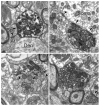
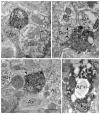
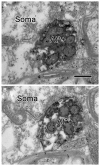
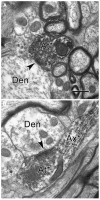
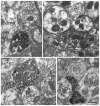


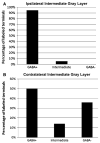

Similar articles
-
The feedback circuit connecting the central mesencephalic reticular formation and the superior colliculus in the macaque monkey: tectal connections.Exp Brain Res. 2008 Aug;189(4):485-96. doi: 10.1007/s00221-008-1444-3. Epub 2008 Jun 14. Exp Brain Res. 2008. PMID: 18553075 Free PMC article.
-
The feedback circuit connecting the superior colliculus and central mesencephalic reticular formation: a direct morphological demonstration.Exp Brain Res. 2000 Mar;131(1):10-21. doi: 10.1007/s002219900280. Exp Brain Res. 2000. PMID: 10759167
-
Anatomical evidence that the superior colliculus controls saccades through central mesencephalic reticular formation gating of omnipause neuron activity.J Neurosci. 2013 Oct 9;33(41):16285-96. doi: 10.1523/JNEUROSCI.2726-11.2013. J Neurosci. 2013. PMID: 24107960 Free PMC article.
-
Anatomical evidence for interconnections between the central mesencephalic reticular formation and cervical spinal cord in the cat and macaque.Anat Rec (Hoboken). 2008 Feb;291(2):141-60. doi: 10.1002/ar.20644. Anat Rec (Hoboken). 2008. PMID: 18213702 Free PMC article.
-
The organization of GABAergic neurons in the mammalian superior colliculus.Prog Brain Res. 1992;90:219-48. doi: 10.1016/s0079-6123(08)63616-x. Prog Brain Res. 1992. PMID: 1321459 Review.
Cited by
-
Connections between the zona incerta and superior colliculus in the monkey and squirrel.Brain Struct Funct. 2018 Jan;223(1):371-390. doi: 10.1007/s00429-017-1503-2. Epub 2017 Aug 29. Brain Struct Funct. 2018. PMID: 28852862 Free PMC article.
-
Reticular Formation Connections Underlying Horizontal Gaze: The Central Mesencephalic Reticular Formation (cMRF) as a Conduit for the Collicular Saccade Signal.Front Neuroanat. 2017 Apr 25;11:36. doi: 10.3389/fnana.2017.00036. eCollection 2017. Front Neuroanat. 2017. PMID: 28487639 Free PMC article.
-
Structural connectivity of autonomic, pain, limbic, and sensory brainstem nuclei in living humans based on 7 Tesla and 3 Tesla MRI.Hum Brain Mapp. 2022 Jul;43(10):3086-3112. doi: 10.1002/hbm.25836. Epub 2022 Mar 19. Hum Brain Mapp. 2022. PMID: 35305272 Free PMC article.
-
Internal organization of medial rectus and inferior rectus muscle neurons in the C group of the oculomotor nucleus in monkey.J Comp Neurol. 2015 Aug 15;523(12):1809-23. doi: 10.1002/cne.23760. Epub 2015 Apr 2. J Comp Neurol. 2015. PMID: 25684641 Free PMC article.
-
GABAergic and non-GABAergic projections to the superior colliculus from the auditory brainstem.Brain Struct Funct. 2018 May;223(4):1923-1936. doi: 10.1007/s00429-017-1599-4. Epub 2018 Jan 4. Brain Struct Funct. 2018. PMID: 29302743 Free PMC article.
References
-
- Appell PP, Behan M. Sources of subcortical GABAergic projections to the superior colliculus in the cat. J Comp Neurol. 1990;302:143–158. - PubMed
-
- Arai K, Das S, Keller EL, Aiyoshi E. A distributed model of the saccade system: simulations of temporally perturbed saccades using position and velocity feedback. Neural Netw. 1999;12:1359–1375. - PubMed
-
- Araki M, McGeer PL, McGeer EG. Presumptive γ-aminobutyric acid pathways from the midbrain to the superior colliculus studied by a combined horseradish peroxidase- γ-aminobutyric acid transaminase pharmacohistochemical method. Neuroscience. 1984;13:433–439. - PubMed
-
- Beckstead RM. Long collateral branches of substantia nigra pars reticulata axons to thalamus, superior colliculus and reticular formation in monkey and cat. Multiple retrograde neuronal labeling with fluorescent dyes. Neuroscience. 1983;10:767–779. - PubMed
Publication types
MeSH terms
Substances
Grants and funding
LinkOut - more resources
Full Text Sources

